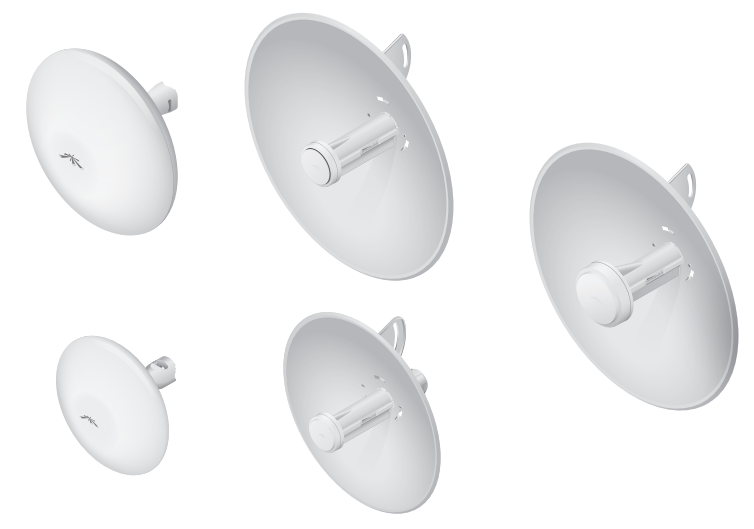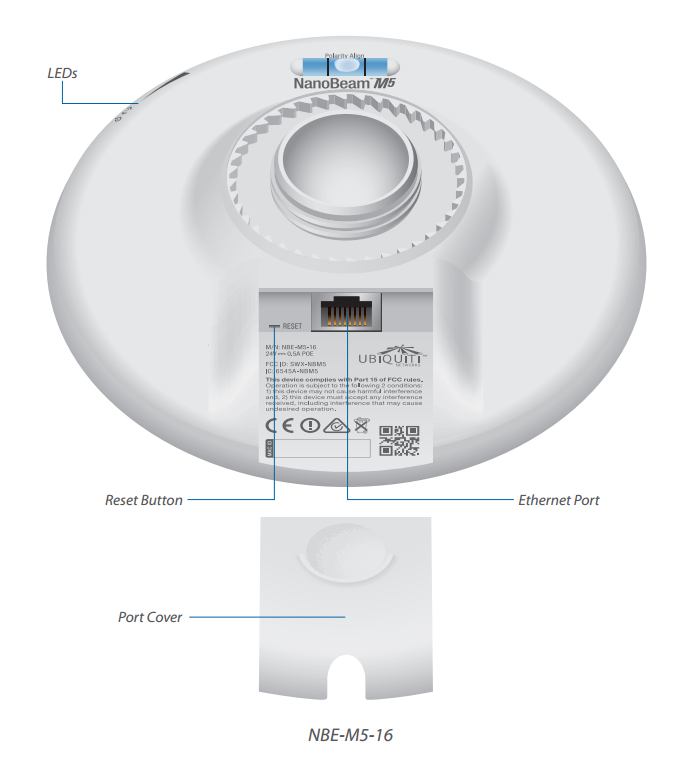NanoBeam
Ubiquiti Networks has long and securely occupied its niche in the market for equipment for wireless networks. The interest of users to the NanoStation and NanoBridge product lines can be called, if not a rush, then surely popular - for sure. The manufacturer decided to combine business with pleasure and to bring "in the light" a new series of devices familiar concept - NanoBeam.

In the new line of equipment, the company remained true to the concept of CPE (Customer Premises Equipment - User Mounted Equipment), characteristic of several Ubiquiti iron series. Taking into account the manufacturer’s love for all-in-one devices, it’s not at all surprising to see a monolithic, usual milky color rounded plastic case, requiring only one wire from the PoE injector for installation (which, in fact, is also not unusual - all the same 24V, 0.5A without load control, a kind of standard Ubiquiti) and a metal clamp for fastening to a pipe stand / mast.

')
The new family of “yubikov”, in principle, is expected to be differentiated in antenna parameters and external design: the NBE-M5-16 and NBE-M5-19 models are presented with a gain of 16 and 19 dBi, respectively, in a streamlined-round design and the NBE-M2 model 400 (PBE-M2-400) , NBE-M5-300 (PBE-M5-300) and NBE-M5-400 (PBE-M5-400) (as always, M2 and M5 denote the range, and 300 and 400 - the diameter of the reflector) in 18, 22 and 25 dBi, respectively, with the “plate” look familiar to NanoBridge. From the new one: in the “streamlined” version, a new scheme of suspension mechanics on a spherical element is implemented, which makes it possible to adjust the device quickly, accurately and conveniently.

The good news is that the NBE-M5-19 and NBE-M5-400 carry a gigabit port onboard. Actually, this is connected with the transition to a new technological platform: in comparison with NanoBridge, for example, a new processor (Atheros MIPS 74KC, 560 MHz vs. Atheros MIPS 24KC, 400MHz), a larger amount of faster memory (64 MB DDR2 against 32 or 64 MB SDRAM). All this should allow new devices to handle more loaded PtMP networks.
Actually, now you can ask a logical question - where to use these devices? Taking into account the analogies carried out in the process of analyzing the design and functionality of NanoBeam, we can confidently state the positioning of these units as a replacement for NanoBridge - especially since the model range has become wider, which means the line of devices has become much more flexible. Everything speaks in favor of the affirmation of similarity, from the form factor of devices to the frequency range and KU antennas. Thus, we get a kind of deep upgrade of the old familiar line with the possibility of a more accurate selection of characteristics to the requirements of a particular consumer.

In the new line of equipment, the company remained true to the concept of CPE (Customer Premises Equipment - User Mounted Equipment), characteristic of several Ubiquiti iron series. Taking into account the manufacturer’s love for all-in-one devices, it’s not at all surprising to see a monolithic, usual milky color rounded plastic case, requiring only one wire from the PoE injector for installation (which, in fact, is also not unusual - all the same 24V, 0.5A without load control, a kind of standard Ubiquiti) and a metal clamp for fastening to a pipe stand / mast.

')
Mechanics and Electronics
The new family of “yubikov”, in principle, is expected to be differentiated in antenna parameters and external design: the NBE-M5-16 and NBE-M5-19 models are presented with a gain of 16 and 19 dBi, respectively, in a streamlined-round design and the NBE-M2 model 400 (PBE-M2-400) , NBE-M5-300 (PBE-M5-300) and NBE-M5-400 (PBE-M5-400) (as always, M2 and M5 denote the range, and 300 and 400 - the diameter of the reflector) in 18, 22 and 25 dBi, respectively, with the “plate” look familiar to NanoBridge. From the new one: in the “streamlined” version, a new scheme of suspension mechanics on a spherical element is implemented, which makes it possible to adjust the device quickly, accurately and conveniently.

The good news is that the NBE-M5-19 and NBE-M5-400 carry a gigabit port onboard. Actually, this is connected with the transition to a new technological platform: in comparison with NanoBridge, for example, a new processor (Atheros MIPS 74KC, 560 MHz vs. Atheros MIPS 24KC, 400MHz), a larger amount of faster memory (64 MB DDR2 against 32 or 64 MB SDRAM). All this should allow new devices to handle more loaded PtMP networks.
What for?
Actually, now you can ask a logical question - where to use these devices? Taking into account the analogies carried out in the process of analyzing the design and functionality of NanoBeam, we can confidently state the positioning of these units as a replacement for NanoBridge - especially since the model range has become wider, which means the line of devices has become much more flexible. Everything speaks in favor of the affirmation of similarity, from the form factor of devices to the frequency range and KU antennas. Thus, we get a kind of deep upgrade of the old familiar line with the possibility of a more accurate selection of characteristics to the requirements of a particular consumer.
| NBE-M5-16 | NBE-M5-19 | NBE-M2-400 | NBE-M5-300 | NBE-M5-400 | |
|---|---|---|---|---|---|
| Network interfaces | (1) 10/100 Ethernet Port | (1) 10/100/1000 Ethernet Port | (1) 10/100 Ethernet Port | (1) 10/100 Ethernet Port | (1) 10/100/1000 Ethernet Port |
| Maximum power consumption | 6 W | 8 W | 6 W | 6 W | 8 W |
| Polarization | Double linear | Double linear | Double linear | Double linear | Double linear |
| Frequency range, MHz | 5170 - 5875 | 5170 - 5875 | 2405 - 2475 | 5170 - 5875 | 5170 - 5875 |
| Nutrition | Passive PoE (without active load control), 24V @ 0,5A | Passive PoE (without active load control), 24V @ 0,5A | Passive PoE (without active load control), 24V @ 0,5A | Passive PoE (without active load control), 24V @ 0,5A | Passive PoE (without active load control), 24V @ 0,5A |
| Mounting method | Kit for truboostkuyu + possibility of wall mounting | Kit for truboostkuyu + possibility of wall mounting | Kit under the pipe rack | Kit under the pipe rack | Kit under the pipe rack |
Source: https://habr.com/ru/post/209848/
All Articles